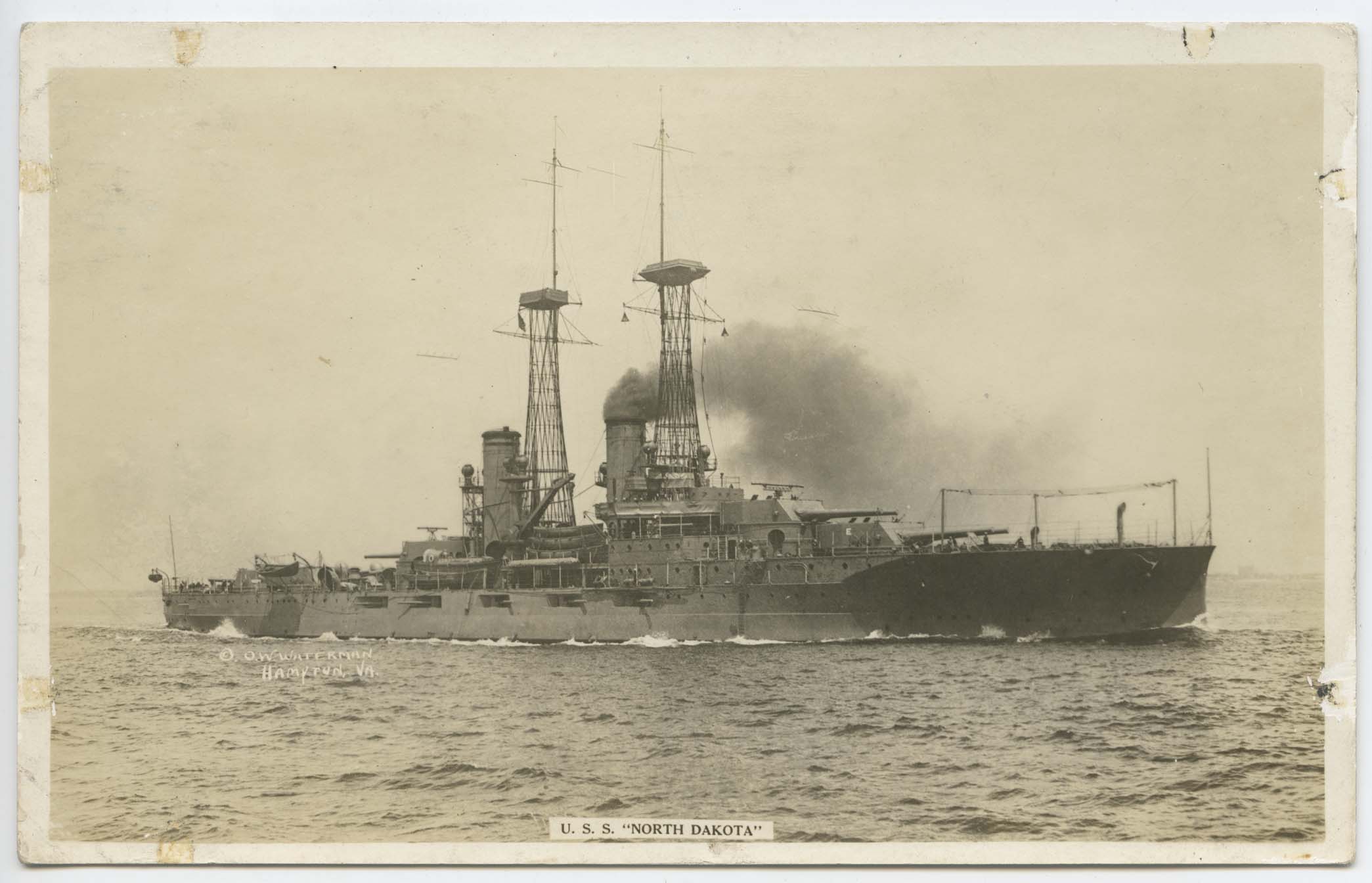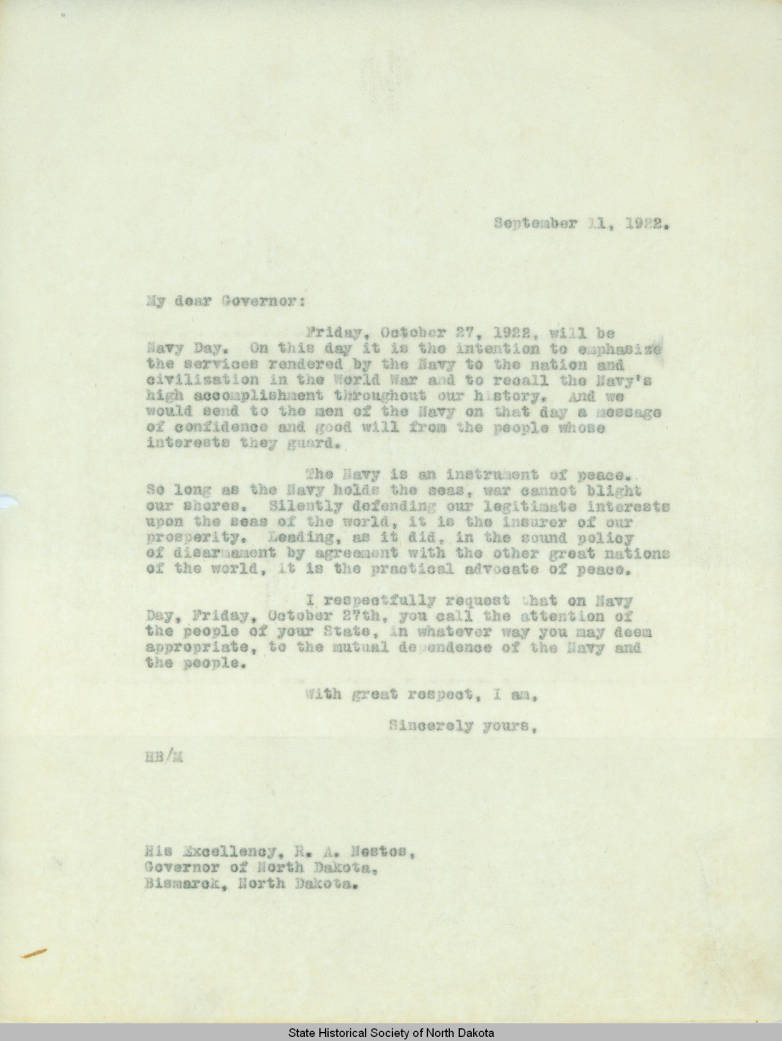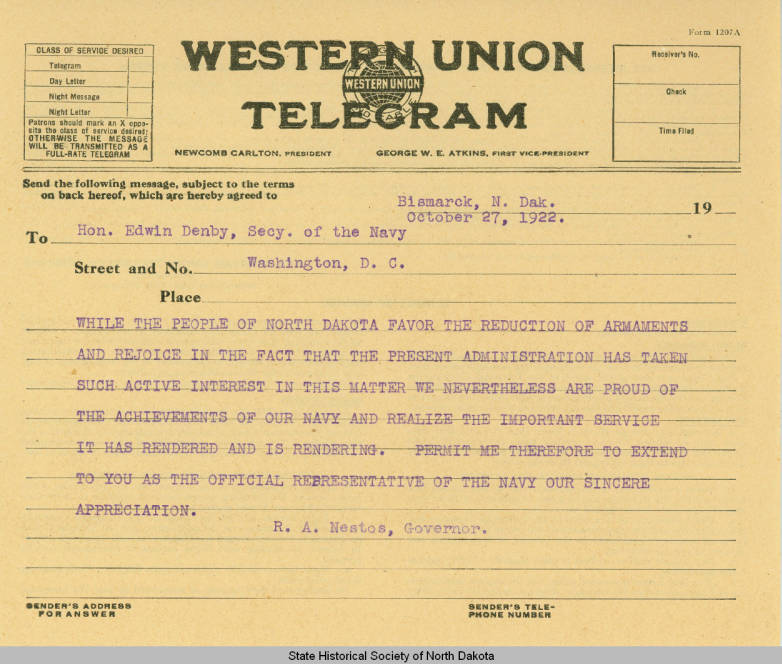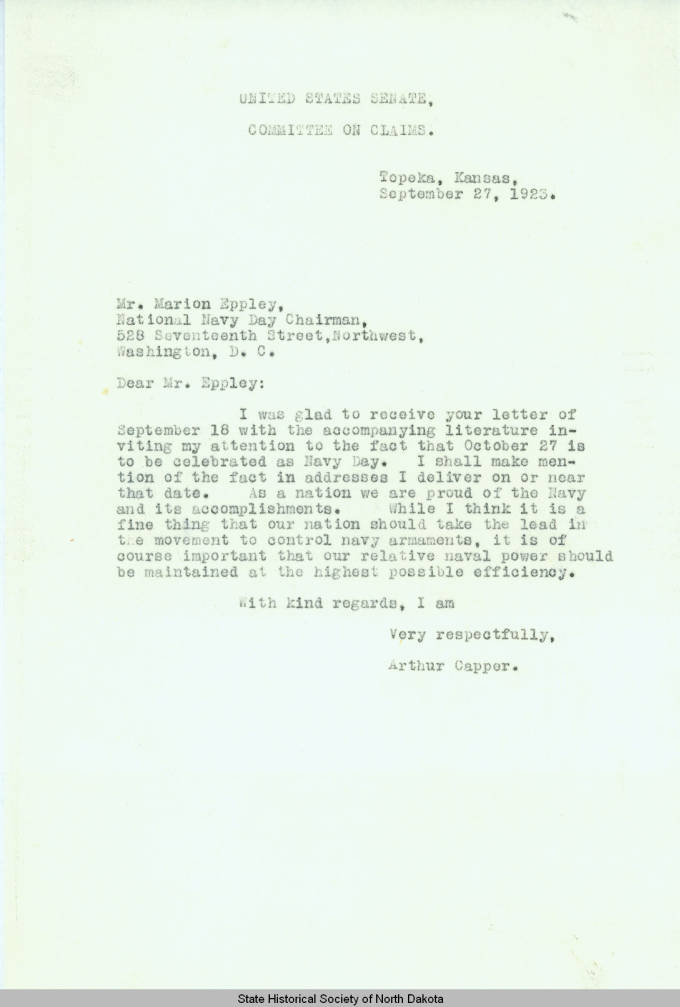The first supporting question, “what was the “all big gun,” or ABG debate?” helps students use sources to unwrap the context of the time and topic being examined. On November 10, 1908, the first American dreadnought battleship, the USS North Dakota was christened by Mary Benton of Fargo as it slid from its construction site into the water. The ship was the biggest, heaviest, and fastest ship yet built by any navy. The ship, its builders, the navy, the United States, and North Dakota were praised in superlatives. The Fargo Forum printed a front-page headline declaring the ship to be “Uncle Sam’s Biggest Peacemaker.” Governor John Burke, speaking at the formal launching ceremonies at Fore River Shipyard in Quincy, Massachusetts stated that “this is the greatest fighting machine in the world . . . named after the greatest agricultural state in this union.”
The ship’s design reflected the lessons American Navy officers learned in defeating the Spanish in 1898. A US Navy officer, Commander Homer C. Poundstone had noted that while the US won the war, on average only two per cent of shells fired from US ships hit their target. Poundstone theorized that locating the proper range of fire required different calculations for guns of different sizes mounted on the ships. In the confusion of battle, this led to inaccuracy in placing shots. In 1903 Poundstone designed two models for all-big-gun ships—an entirely new idea in ship construction - but the plans were set aside with little further attention.
The 1905 Russo-Japanese War, in which Great Britain played a supporting role as Japan’s ally, led British naval engineers to think about more effective battleships. The British ship, HMS Dreadnought, was soon built along the lines of the all-big-gun ships proposed by Commander Poundstone. So impressive was the Dreadnought that its name came to represent an entire generation of battleships. The USS North Dakota was the first American dreadnought to launch (its sister ship, USS Delaware was launched shortly after). Other nations followed suit: Germany, France, Italy, and Japan began to enlarge their navies with all-big-gun battleships.
The USS North Dakota was not completed and ready to sail until April 11, 1910. Over the next thirteen years, she sailed along the east coast, the Caribbean Sea, the coast of Mexico, and to Guantanamo Bay, Cuba. She patrolled the east coast from Virginia to Long Island during World War I, and trained midshipmen from the US Naval Academy. She toured ports on the Mediterranean Sea in 1919. Her crew took honors in target practice on the open sea, hitting targets as far as 10 miles away at a rate exceeding thirty per cent.
The ship, however, was also troubled by engine breakdowns, a major explosion in September 1910, and a fire. Some Naval officers had complained as the ship was being built in 1907 and 1908 that the design was flawed, the guns were inadequate, and the turbine engines were of an inferior design. The debate raged over the North Dakota’s design in such respectable journals as The New York Times and Scientific American. The Grand Forks Herald referred to the debate in its articles about the launching of the ship but assured North Dakotans that the critics were not on solid footing.
Were the critics right? The debate centered on many technical aspects of the ship, as well as national preparation for a possible war, cost of armaments, speed of production, and the honor of the US Navy command. Read both sides of the debate before making your decision. Complete the following task using the sources provided to build a context of the time period and topic being examined.
Formative Performance Task 1
Facilitate a discussion or debate over the construction of the USS North Dakota. Participants can either be assigned teams or individually represent different perspectives including Lieutenant, Commander, Admiral, President of the United States, etc. Each person should have a list of the positions they represent and be prepared to argue for their position. Alternative debate topics include the concept of disarmament, or whether the cost of building the All Big Gun ships (or dreadnoughts) was a worthwhile investment in the security of the United States. Learn more about the Washington Naval Arms Limitation Treaty in its scope and purpose. Read about Navy budgets here and here.
Featured Sources 1
The sources featured below are primary sources. They are the raw materials of history—original documents, personal records, photographs, maps, and other materials. Primary sources are the first evidence of what happened, what was thought, and what was said by people living through a moment in time. These sources are the evidence by which historians and other researchers build and defend their historical arguments, or thesis statements. When using primary sources in your lessons, invite students to use all their senses to observe, describe, and analyze the materials. What can they see, hear, feel, smell, and even taste? Draw on students’ knowledge to classify the sources into groups, to make connections between what they observe and what they already know, and to help them make logical claims about the materials that can be supported by evidence. Further research of materials and sources can either prove or disprove the students’ argument.
Read featured sources A-F. In a group or as a class, answer the following questions: What type of sources are they (letters, photos, maps, diaries, etc.)? What kind of information do they contain? Who created each of these sources? Who was the intended audience for each source? Why were these sources created? When were the sources created? What do the sources tell us about farming during that time? How do we know? What else can you find? Identify specific sentences that support your findings.
| Source A |
U.S.S. North Dakota 
SHSND: 2002-P-15-Album2-P14b |
| Source B |
Critics In 1906, a man named Henry Reuterdahl launched a series of criticisms at the Navy Department, most of them based on organization. Though Reuterdahl’s arguments did not reflect on the new battleships, they left the Navy Department defensive about any criticism. So, when Navy Lieutenant Commander Albert L. Key began to raise questions about the construction of the North Dakota as it was being built in 1907, a debate among navy officers ensued. Commander Key was assigned to the USS Salem which was under construction nearby. He visited and studied the North Dakota often and submitted to the Secretary of the Navy a list of objections to its design. The disturbance caused by his assessment of the battleship led to a Naval Conference called by President Theodore Roosevelt, who had been Assistant Secretary of the Navy from 1897 to 1898 and maintained a strong interest in the Navy and its representation of US power abroad. At this conference, Key’s observations were under discussion. He had a good deal of support from other officers, though Navy regulations prevented them from speaking publicly on the matter. The New York Times and Scientific American sought information on the matter of the North Dakota’s effectiveness and safety. Both printed articles on the debates before and after the Newport Naval Conference held in August 1908. The official report of the conference was released in November, just three days before the ship was launched. The following statements concerning the North Dakota are taken from these journals as well as Captain Gilbert F. Rindahl’s study of the ship which was published in North Dakota History 32 (April 1965): 107 – 116.
|
| Source C |
Defenders The Navy was anxious to clear the controversy over the North Dakota’s construction and design. Navy leaders agreed to meet under the leadership of President Roosevelt at the Naval War College at Newport, Rhode Island to discuss the complaints and to adjust if necessary or practical. President Roosevelt was disturbed by the nature and frequency of the criticism of the North Dakota. The conference was to proceed in secrecy though the names of the participants were public. Among the officers were six Rear Admirals, several Naval Constructors, and Commander Albert L. Key. The plans for the North Dakota (Battleship 29) and the Delaware had been submitted to Congress in 1906 along with a construction budget. Similar plans had been submitted to Congress for appropriations for the next ships to be built, the Florida and the Utah. Roosevelt, who had, as president, promoted a strong Navy, wanted to be sure that all four ships would be among the most powerful in the world. During the conference, a news story was published stating that the ships of the Delaware class (including the North Dakota) were unsatisfactory. Roosevelt responded on August 21, 1908 with characteristic vigor: There is no question about the plans being unsatisfactory; merely as to whether they cannot be made even better. The North Dakota [Delaware] class is undoubtedly better than any ships now afloat. The conference is simply engaged in the effort to try to make them better still. The President, however, had temporarily halted work on the battleships until he saw new plans for that class of ship. A week later, President Roosevelt approved of the plans for the new ships with just a few adjustments. All the new ships (after the North Dakota and Delaware) would have turbine engines, and each would have two extra 5-inch torpedo guns. The following statements in defense of the ships’ design and construction are taken from the New York Times, the Grand Forks Herald, and Scientific American.
|
ABG Debate Conclusion
Both sides claimed victory following the conference. Commander Key and his allies announced that the ventilators would be armored, the guns would be improved on the next generation of ships, and the powder magazines would be refrigerated. The senior officers at the conference generally defended the North Dakota’s construction and design stating that changes in design could not be ordered so late in the construction process and that some sacrifices had to be made so that the ship could meet the desired weight and speed. Though there were problems with the early models of the turbine engine, the officers generally approved of the smooth-running engine which allowed them to accurately place shots from the big guns.
With very few changes, the North Dakota was launched three days after the release of the report from the Newport Conference. The final details of construction were completed, and she went to sea in April 1910 with a crew of more than 900 officers and men. She acquired an honorable record in many respects and was noted for the good feeling between the officers and the enlisted men. One report noted that the officers were careful to explain the tasks expected of the seamen thoroughly so that if one were disabled, another could take his place. Very likely, the North Dakota’s officers contributed to the education of the enlisted men when on board schooling was suggested by Secretary of the Navy Josephus Daniels in 1913. The entire crew cheered the success of the North Dakota’s gunnery exercises in 1911 when the ship won the fleet’s coveted red flag with the black ball in the center for hitting a target at nearly 10 miles distance over 30 per cent of the time.
The ship never saw combat, so the effectiveness of the armor belt location was not resolved with this ship. However, the debate over construction was not the last time the North Dakota would have the spotlight. She entered another debate in 1922 when she was on the list of older ships to be de-commissioned and destroyed under the terms of the Naval Arms Limitation Treaty.
Treaty
World War I was sometimes called The War to End All Wars. The amount of material destruction and the numbers of lives lost and/or ruined appalled the citizens of modern nations many of whom believed that wars were a residue of our savage past. Indeed, the warring nations formed in 1919 the League of Nations, an international organization which provided a forum for discussing international disputes. (The United States did not join the League of Nations.)
Some people, especially in the United States and Great Britain, thought that the arms race, particularly in naval vessels, had contributed to the outbreak of war, and that the frantic effort to build more, and more powerful, battleships had been an enormous and possibly debilitating expense to their national economies.
The Republican platform in the 1920 presidential race contained a naval disarmament plank which committed President Warren G. Harding to pursue arms limitation in his presidency. Republican Senator William Borah of Idaho represented these interests in the Senate where he fostered the idea of an international naval arms limitation conference. Those who supported Borah’s plan believed, as did Senator Hiram Johnson (Republican) of California, that "War may be banished from the earth more nearly by disarmament than . . . in any other manner.”
The resulting Washington Naval Arms Limitation Treaty of 1922 was signed by the United States, Great Britain, France, Italy, and Japan. These nations agreed to limit battleships according to total tonnage of ships (mostly battleships), allowing the US (and Great Britain) 525,000 tons displacement. More than 800,000 tons of older ships were to be destroyed to meet the limit on tonnage. The USS North Dakota was identified in the treaty as one of the ships to be “disposed of” in a prescribed manner. The Rules for Scrapping Vessels of War (Treaty Ch 2, Pt 2) required that the ship be permanently sunk, broken up, or converted to target use exclusively.
The North Dakota sailed until September 1923, when the Navy announced that the ship would become a radio controller’s target during maneuvers in the Caribbean Sea over the coming winter. When that exercise failed, the ship was placed in “mothballs” at Norfolk Navy Yard for the next eight years. In 1931, the ship was sold for $87,206 to be cut apart by torches and turned into scrap metal.
Disarmament was not a simple idea. Just a decade earlier many US citizens thought that peace could be assured by a powerful navy protecting our shores. However desirable permanent peace may have been in 1922, it was an uncertain ideal in a world that seemed populated by aggressive, acquisitive nations. The ideas of peace and preparedness remained entangled over the next two decades.
Sources: Washington Naval Arms Limitations Treaty
Documents
This section contains three documents from the collection of Edith Wakeman Hughes. Mrs. Hughes was the chairperson of the first Navy Day in North Dakota in October 1922. While these documents concern Navy Day rather than disarmament, they contain sentiments about arms and peace that reveal the intertwining of our desire for peace insured by a well-armed nation. Remarks from Rear Admiral Mahan are also included.
The following quote is an excerpt from statements made by Rear Admiral Alfred Thayer Mahan (September 27, 1840–December 1, 1914) that were published in the Bismarck Tribune on September 15, 1914, just as Europe was beginning to engage in World War I. Admiral Mahan is regarded as the man who designed the modern navy in the 1880s.
“The problem of the A-B-G (all big guns) ship is a highly interesting one, and we may learn through this war of its worth. But the lesson will not be shown in any ship-to-ship fight. Dreadnaught against dreadnaught will be no different than one old frigate against another old frigate in the days gone by.
The really interesting and instructive combat would be between, say, a dozen dreadnaughts and a dozen and a half smaller battleship size. We might see whether or not the 12- or 14-inch gun is of so great importance as has lately been asserted.
I cannot say that I agree with the idea of the A-B-G ships. England, of course, originated the original dreadnaught, and cackled like a chicken that had laid an egg, and got everyone else building A-B-Gs. But I think all the navies are coming around to what we called the mixed battery ship, and that is as it should be.”
Edith Wakeman Hughes Papers: SHSND 10114
| Source D | 
The first letter, dated September 11, 1922, was written by the national chairman of the Navy Day committee inviting Governor Nestos of North Dakota to participate in Navy Day. Note especially the middle paragraph which suggests that the Navy ensures peace through power. http://www.digitalhorizonsonline.org/digital/collection/uw-ndshs/id/3451 |
| Source E | 
The second letter, a telegram from Governor Nestos to Secretary of the Navy Edwin Denby, indicates that North Dakotans favor Naval Disarmament while honoring the accomplishments of the Navy. http://www.digitalhorizonsonline.org/digital/collection/uw-ndshs/id/3448 |
| Source F | 
In the third letter, Senator Arthur Capper of Kansas pledges to honor Navy Day in 1923 while expressing his approval of both arms limitation and the importance of “naval power.” http://www.digitalhorizonsonline.org/digital/collection/uw-ndshs/id/3449 |
Visit the North Dakota Heritage Center & State Museum to see a model of the USS North Dakota and artifacts from the actual ship.


